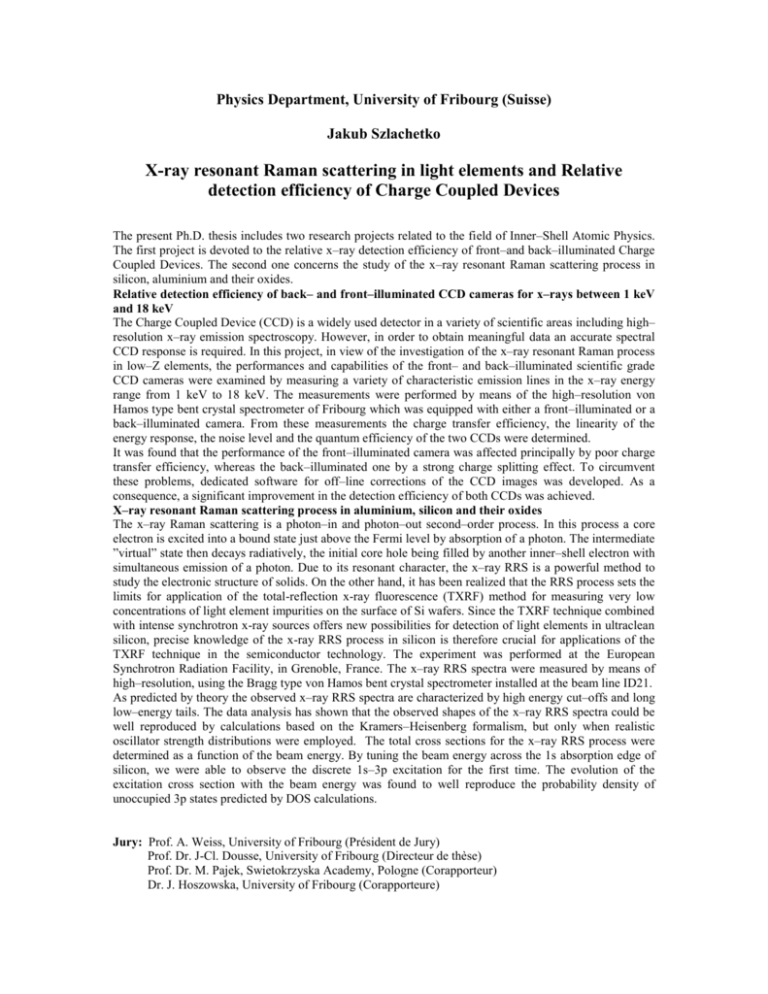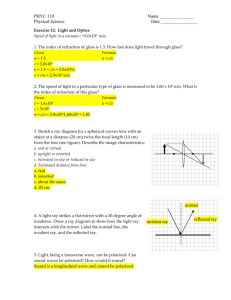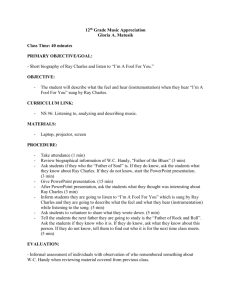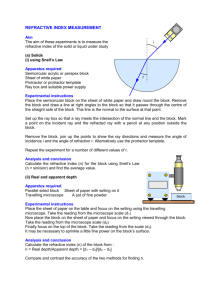X-ray resonant Raman scattering in light elements and Relative
advertisement

Physics Department, University of Fribourg (Suisse) Jakub Szlachetko X-ray resonant Raman scattering in light elements and Relative detection efficiency of Charge Coupled Devices The present Ph.D. thesis includes two research projects related to the field of Inner–Shell Atomic Physics. The first project is devoted to the relative x–ray detection efficiency of front–and back–illuminated Charge Coupled Devices. The second one concerns the study of the x–ray resonant Raman scattering process in silicon, aluminium and their oxides. Relative detection efficiency of back– and front–illuminated CCD cameras for x–rays between 1 keV and 18 keV The Charge Coupled Device (CCD) is a widely used detector in a variety of scientific areas including high– resolution x–ray emission spectroscopy. However, in order to obtain meaningful data an accurate spectral CCD response is required. In this project, in view of the investigation of the x–ray resonant Raman process in low–Z elements, the performances and capabilities of the front– and back–illuminated scientific grade CCD cameras were examined by measuring a variety of characteristic emission lines in the x–ray energy range from 1 keV to 18 keV. The measurements were performed by means of the high–resolution von Hamos type bent crystal spectrometer of Fribourg which was equipped with either a front–illuminated or a back–illuminated camera. From these measurements the charge transfer efficiency, the linearity of the energy response, the noise level and the quantum efficiency of the two CCDs were determined. It was found that the performance of the front–illuminated camera was affected principally by poor charge transfer efficiency, whereas the back–illuminated one by a strong charge splitting effect. To circumvent these problems, dedicated software for off–line corrections of the CCD images was developed. As a consequence, a significant improvement in the detection efficiency of both CCDs was achieved. X–ray resonant Raman scattering process in aluminium, silicon and their oxides The x–ray Raman scattering is a photon–in and photon–out second–order process. In this process a core electron is excited into a bound state just above the Fermi level by absorption of a photon. The intermediate ”virtual” state then decays radiatively, the initial core hole being filled by another inner–shell electron with simultaneous emission of a photon. Due to its resonant character, the x–ray RRS is a powerful method to study the electronic structure of solids. On the other hand, it has been realized that the RRS process sets the limits for application of the total-reflection x-ray fluorescence (TXRF) method for measuring very low concentrations of light element impurities on the surface of Si wafers. Since the TXRF technique combined with intense synchrotron x-ray sources offers new possibilities for detection of light elements in ultraclean silicon, precise knowledge of the x-ray RRS process in silicon is therefore crucial for applications of the TXRF technique in the semiconductor technology. The experiment was performed at the European Synchrotron Radiation Facility, in Grenoble, France. The x–ray RRS spectra were measured by means of high–resolution, using the Bragg type von Hamos bent crystal spectrometer installed at the beam line ID21. As predicted by theory the observed x–ray RRS spectra are characterized by high energy cut–offs and long low–energy tails. The data analysis has shown that the observed shapes of the x–ray RRS spectra could be well reproduced by calculations based on the Kramers–Heisenberg formalism, but only when realistic oscillator strength distributions were employed. The total cross sections for the x–ray RRS process were determined as a function of the beam energy. By tuning the beam energy across the 1s absorption edge of silicon, we were able to observe the discrete 1s–3p excitation for the first time. The evolution of the excitation cross section with the beam energy was found to well reproduce the probability density of unoccupied 3p states predicted by DOS calculations. Jury: Prof. A. Weiss, University of Fribourg (Président de Jury) Prof. Dr. J-Cl. Dousse, University of Fribourg (Directeur de thèse) Prof. Dr. M. Pajek, Swietokrzyska Academy, Pologne (Corapporteur) Dr. J. Hoszowska, University of Fribourg (Corapporteure)






